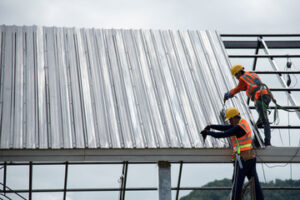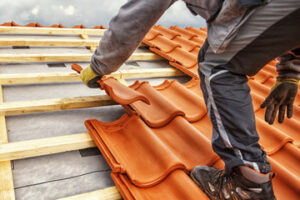Performing proper maintenance on your roof can help prevent serious problems down the road. Inspecting your roof regularly and promptly addressing any issues will save you money and stress in the long run.

Tree limbs and debris can damage the roof, so it’s important to trim trees that hang over the roof on a regular basis. Roofing cement can seal small leaks and secure loose shingles. Contact Five Star Roofing and Contracting for professional help.
Like other roof materials, shingles should be inspected and maintained on a regular basis. This typically involves identifying problem areas, sealing fasteners, removing debris (leaf litter, branches, pine cones), and ensuring that flashing remains in place around penetrations. For tasks that require climbing or reaching high areas, hiring a roofing contractor to do the work safely is often best.
A well-maintained shingle roof can help extend the lifespan of the shingles and improve energy efficiency in your home. It can also protect the roof and exterior of your home from the elements, and help to reduce external noise.
Asphalt shingles are durable and aesthetically pleasing, providing an attractive appearance to any home. They are available in a wide variety of colors and styles, and can be customized to match your home’s architecture. They are easy to repair and replace, making them a cost-effective option for homeowners who want to update their roof.
Many shingle roofs are built with energy efficiency in mind, with some featuring underlayment that helps to lower the home’s overall energy usage. They are also fire and weather resistant, with some even offering algae resistance.
Shingle roofs are one of the most affordable roofing options, but they must be properly maintained to get the maximum benefit from them. Keeping the roof clear of debris and scheduling regular inspections can help to avoid costly repairs in the future. For example, catching a single missing shingle early on can save you the expense of replacing the entire roof later on. The same goes for identifying and fixing problems with cracked, curled, or flat shingles.
Metal Roofs
Metal roofs are durable and low maintenance, but they do need a little attention from time to time. Regular cleaning, inspections of panel seams and fasteners, and addressing any leaks promptly will help prevent small problems from becoming extensive repairs or even replacement costs.
Like shingle roofs, metal roofs come in a wide range of styles to fit any aesthetic. Standing seam metal roofing, for example, has a clean, modern look that suits both traditional and contemporary homes. Other types of metal roofing can add a rustic or classic touch to a home and are available in many colors and finishes.
A metal roof’s appearance can be greatly enhanced with periodic washings that remove dust, dirt and other debris. The washing solution is usually a combination of mild detergent and water. It’s important to use a soft brush or sponge, however, as power washers can damage the surface of the metal. Scratches, scuffs and chalking may occur, and can be touched up with a special paint pen.
If the metal roof is screw-down instead of a standing seam style, it will need to be inspected regularly for loose screws. Loose screws can be a source of leaks because the metal expands and contracts as it heats and cools. If the screws are tightened to a point where they’re pulling out of the holes, or are missing altogether, it’s best to have a professional replace them.
Check the sealant and flashing around pipes, chimneys, vents, skylights and other penetrations. Re-sealing and repairing these areas will keep the roof watertight. Check for dents or dimples in the metal panels as well. These can be repaired with a rubber mallet or other tool to gently tap them back into place.
Gutters
Gutters are the troughs fixed along a building’s roofline to catch rainwater and direct it away from the structure. Without them, water would simply dump straight off the roof and gather at the foundation, wrecking landscaping, staining walls, and causing serious issues with the house’s foundation.
Gutter systems are typically installed at a slight slope to ensure the proper flow of water, and the bottom opening of each gutter is angled downward to allow water to flow into downspouts or drainpipes. A downspout is a vertical pipe that sits at the end of each gutter, and when it is clogged, the system is no longer able to redirect water effectively.
It’s important to check on the state of your gutters regularly, especially when it rains. If water flows over the sides of your gutters, or if the downspouts are loosened from the gutters themselves, it is time to call in professional help.
Leaking gutters can lead to major problems for your home’s exterior and interior, from wood rot and fungus to mold growth and structural damage. Regular maintenance and routine gutter cleaning can help to prevent clogs, leaks, and other gutter-related problems that can be costly to repair.
It’s best to clean out your gutters at least twice a year, in the spring and fall. This is not a project that you should attempt on your own, however, as it’s a dangerous job and requires a sturdy ladder with proper stabilization. You’ll also want to wear heavy gloves to protect your hands from debris and sharp edges. It’s also a good idea to spread a large tarp beneath your work area to toss the gunk you remove from the gutter troughs.
Chimneys and Vents
While a chimney may appear to be the cherry on top of your roofline, it serves an important purpose. It carries dangerous toxins and gases, as well as combustion byproducts, safely outside your home to the environment. Chimneys also work with other systems in your house, including heating and plumbing equipment. Because these structures are used in so many ways, they must be safe and functional. Understanding their makeup, terminology, and maintenance can help homeowners understand how they function, as well as distinguish between a chimney, flue, and vent.
Chimneys stack vertically from the peak of your roofline and extend into your attic area. Depending on the type of fireplace, a chimney can contain one or multiple flues. The chimney itself may be capped with a metal cap to keep debris, animals, and rain from entering. A chimney can be built either from bricks, mortar, or masonry, or can be factory-built using stainless steel materials. Often, chimneys are designed with decorative chimney chase covers or siding to match the exterior of the house.
In modern homes, most fireplaces have a flue liner to prevent the hot air, gases, embers, and sparks from contacting unprotected parts of your home. Traditional fireplace flues are lined with fireclay flue tile, asbestos-cement transite pipe, cement, or metal. This material will need to be replaced if it becomes damaged. Today, most people opt to replace traditional chimney liners with stainless steel chimney liners. These liners are inexpensive, easy to install, and are less likely to deteriorate.
Vents and connectors are primarily made of stainless steel, though some types are designed with aluminum or galvanized steel. Vents are manufactured to withstand the high temperatures of gas and wood-burning equipment, and may be single or double-wall pipes. They may also be round, square, or rectangular. Connectors and vents are designed to connect from an appliance to a flue or chimney.
Skylights
Skylights are prized by commercial property owners for their ability to brighten spaces and create a warm and inviting atmosphere. However, they can have some drawbacks, including energy bills that are higher than expected and moisture problems due to leaks around the roof penetration. Preventing these issues requires proactive maintenance.
A regular schedule of cleaning and inspections helps to extend a skylight’s lifespan. This includes ensuring the dome and tubing are free of debris and dirt to preserve light clarity, as well as examining the seals for damage and signs of water intrusion. For openable skylights and ventilation systems, cleaning and lubrication of moving parts is also recommended.
Depending on where they are placed, skylights may expose interior areas to direct sunlight, which can cause furniture, artwork, and flooring to fade over time. Installing frosted or tinted glass can help to preserve privacy and reduce incoming UV radiation.
Leaks are a common problem associated with skylights, especially older models. These often occur when the flashing surrounding the roof penetration wears down and allows rainwater to flow in. Keeping the flashing clear of debris and regularly replacing the seals helps prevent this from happening.
A leaking skylight can cause serious damage to the structure of a building. If it isn’t addressed quickly, a ceiling collapse could result. It is always best to have a professional take a look at the problem and determine what the cause is. For safety reasons, it is never a good idea to attempt to get on the roof yourself without the proper training and equipment. Injuries can be severe, and falls from even a short distance can have deadly consequences.
